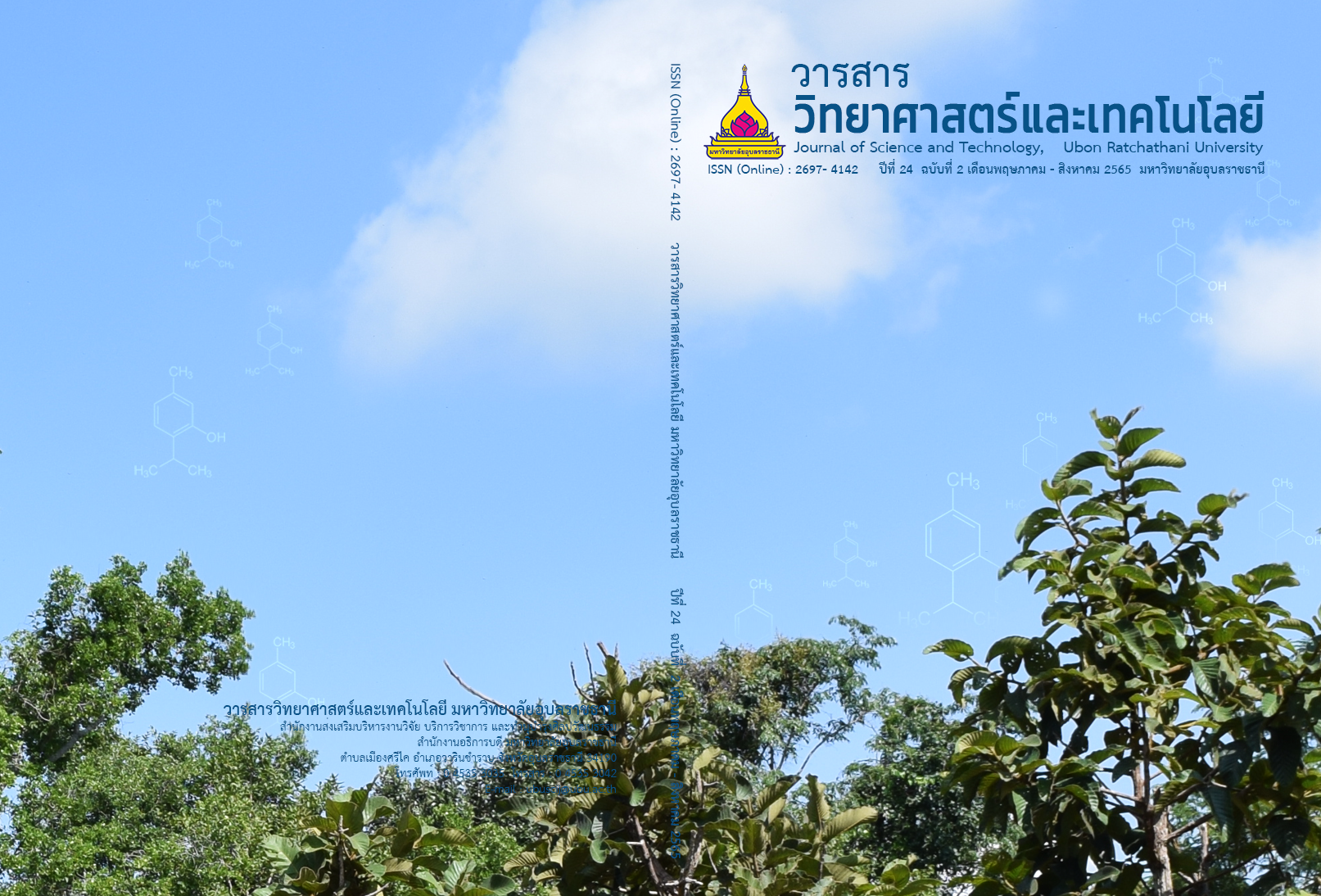ประสิทธิภาพการยับยั้งเชื้อราของสารสกัดหยาบไบโอชาร์
Main Article Content
บทคัดย่อ
ไบโอชาร์ คือวัสดุจำพวกถ่านที่ได้จากการเผาชีวมวล เช่น วัสดุเหลือทิ้งทางการเกษตร ภายใต้กระบวนการที่เรียกว่าไพโรไลซิส ในปัจจุบันมีการนำไบโอชาร์มาใช้ประโยชน์ในด้านการเกษตรเพื่อปรับปรุงคุณภาพของดิน นอกจากนี้ยังมีรายงานว่าสามารถยับยั้งจุลินทรีย์ก่อโรคพืชในดิน ด้วยเหตุนี้การศึกษานี้จึงมีวัตถุประสงค์เพื่อศึกษาประสิทธิภาพในการยับยั้งเชื้อรา Aspergillus sp. และ Penicillium sp. ของสารสกัดหยาบไบโอชาร์ที่ผลิตจากขี้เลื่อย กะลามะพร้าว ไม้กระถิน เปลือกหุ้มเมล็ดยางพารา และไม้ยางพารา โดยทำการสกัดด้วยตัวทำละลาย 2 ชนิดคือ เมทานอลและน้ำกลั่น และใช้ความเข้มข้นของสารสกัดไบโอชาร์ในการทดสอบ 3 ระดับคือ 1, 2 และ 3 เปอร์เซ็นต์โดยปริมาตร จากผลการศึกษาพบว่า สารสกัดไบโอชาร์ต่างชนิดกันสามารถยับยั้งเชื้อราทดสอบได้แตกต่างกัน และความเข้มข้นของสารสกัดไบโอชาร์ที่ใช้มีผลโดยตรงต่อการลดลงของปริมาณเส้นใยรา สารสกัดเมทานอลของไบโอชาร์จากไม้ยางพาราที่ระดับความเข้มข้น 3 เปอร์เซ็นต์โดยปริมาตร ยับยั้งการเจริญของ Aspergillus sp. ได้ดีที่สุด โดยมีเปอร์เซ็นต์การยับยั้งการเจริญของเชื้อรา เท่ากับ 10.56±0.60 เปอร์เซ็นต์ ในขณะที่สารสกัดเมทานอลของไบโอชาร์จากกะลามะพร้าวที่ระดับความเข้มข้น 3 เปอร์เซ็นต์โดยปริมาตร ยับยั้งการเจริญของ Penicillium sp. ได้ดีที่สุด คือ มีเปอร์เซ็นต์การยับยั้งการเจริญของเชื้อรา เท่ากับ 24.31±0.76 เปอร์เซ็นต์ จากการศึกษานี้แสดงให้เห็นถึงศักยภาพในการต้านเชื้อราของไบโอชาร์ ซึ่งสามารถนำไปประยุกต์ใช้ในงานด้านต่าง ๆ ต่อไปได้
Article Details

อนุญาตภายใต้เงื่อนไข Creative Commons Attribution-NonCommercial-NoDerivatives 4.0 International License.
บทความที่ได้รับการตีพิมพ์เป็นลิขสิทธิ์ของ วารสารวิทยาศาสตร์และเทคโนโลยี มหาวิทยาลัยอุบลราชธานี
ข้อความที่ปรากฏในบทความแต่ละเรื่องในวารสารวิชาการเล่มนี้เป็นความคิดเห็นส่วนตัวของผู้เขียนแต่ละท่านไม่เกี่ยวข้องกับมหาวิทยาลัยอุบลราชธานี และคณาจารย์ท่านอื่นๆในมหาวิทยาลัยฯ แต่อย่างใด ความรับผิดชอบองค์ประกอบทั้งหมดของบทความแต่ละเรื่องเป็นของผู้เขียนแต่ละท่าน หากมีความผิดพลาดใดๆ ผู้เขียนแต่ละท่านจะรับผิดชอบบทความของตนเองแต่ผู้เดียว
เอกสารอ้างอิง
Tomczyk, A., Sokołowska, Z. and Boguta, P. 2020. Biochar physicochemical properties: pyrolysis temperature and feedstock kind effects. Reviews in Environmental Science and Bio/Technology. 19: 191-215.
Wijitkosum, S. and Jiwnok, P. 2019. Elemental composition of biochar obtained from agricultural waste for soil amendment and carbon sequestration. Applied Sciences. 9: 3980.
Yu, H. and et al. 2019. Biochar amendment improves crop production in problem soils: A review. Journal of Environmental Management. 232: 8-21.
Yooyen, J., Wijitkosum, S and Sriburi, T. 2015. Increasing yield of soybean by adding biochar. Journal of Environmental Research and Development. 9: 1066–1074.
Pituya, P. and Popradit, A. 2017. Development and restoration of sandy soil in the rain-shadow area with bio-charcoal. VRU Research and Development Journal Science and Technology. 12(3): 27-38. (in Thai)
Farrell, M. and et al. 2013. Microbial utilization of biochar-derived carbon. Science of the Total Environment. 465, 288-297.
Wang, G. and et al. 2019. Suppression of phytophthora blight of pepper by biochar amendment is associated with improved soil bacterial properties. Biology and Fertility of Soils. 55: 813-824.
Thaenthanee, S. and Daosukho, S. 2016. The survival of agricultural microorganisms in biochar. Bulletin of Applied Sciences. 5(5): 89-95. (in Thai)
Wang, G. and et al. 2020. Biochar mediated control of phytophthora blight of pepper is closely related to the improvement of the rhizosphere fungal community. Frontiers in Microbiology. 11: 1-12.
Shahid, M., Jabeen, K. and Iqbal, S. 2018. Evaluation of antifungal potential of wood biochar against Fusarium oxysporum Schlecht. Journal of Biological Society of Pakistan. 64(2): 227-232.
Sehar, A. and et al. 2017. Assessment of biochar and compost antifungal potential against Botryodiplodia theobromae Pat. International Journal of Biology and Biotechnology. 14(4): 585-589.
Munawwar, M., Jabeen, K. and Iqbal, S. 2018. Biochar and compost antifungal activity against Botrytis cinerea Pers. Ex Fr. Bangladesh Journal of Botany. 47(1): 141-146.
Muangkote, S. and et al. 2017. Effect of roasting temperatures of garlic, shallot and dried chili on antifungal activity of Aspergillus niger. Journal of Science and Technology, Ubon Ratchathani University. 19(3): 88-100. (in Thai)
Ghuffar, S. and et al. 2021. Studies of Penicillium species associated with blue mold disease of grapes and management through plant essential oils as non-hazardous botanical fungicides. Green Processing and Synthesis. 10: 21-36.
Habib, W. and et al. 2021. Occurrence and characterization of Penicillium species isolated from post-harvest apples in Lebanon. Toxins. 13: 730.
Teoh, Y.P., Mashitah, M.D. and Salmiah, U. 2015. Antifungal activities of selected wood-degrading fungi of rubberwood. Journal of Tropical Forest Science. 27(3): 325–333.
Petchpradab, P. and et al. 2009. Hydrothermal pretreatment of rubber wood for the sacchari-fication process. Industrial & Engineering Chemistry Research. 48: 4587–4591.
Lobo, F.C.M. and et al. 2021. An Overview of the antimicrobial properties of lignocellulosic materials. Molecules. 26: 1749.
de Meo, C.M.L. and et al. 2020. Lignin isolated from Caesalpinia pulcherrima leaves has antioxidant, antifungal and immunostimulatory activities. International Journal of Biological Macromolecules. 162(1): 1725-1733.
Husseinsyah, S. and Mostapha, M. 2011. The effect of filler content on properties of coconut shell filled polyester composites. Malaysian Polymer Journal. 6(1): 87-97.
Pritha, S.D.S.J. and Karpagam, S. 2018. Antimicrobial activity of coconut shell oil. International Journal of Pharmaceutical Sciences and Research. 9(4): 1628-1631.
Dayrit, F.M. 2015. The properties of lauric acid and their significance in coconut oil. Journal of the American Oil Chemists' Society. 92: 15.


